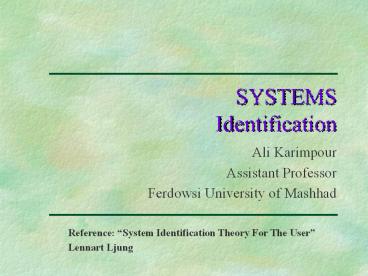SYSTEMS Identification - PowerPoint PPT Presentation
Title:
SYSTEMS Identification
Description:
SYSTEMS Identification Ali Karimpour Assistant Professor Ferdowsi University of Mashhad Reference: System Identification Theory For The User Lennart Ljung – PowerPoint PPT presentation
Number of Views:109
Avg rating:3.0/5.0
Title: SYSTEMS Identification
1
SYSTEMSIdentification
- Ali Karimpour
- Assistant Professor
- Ferdowsi University of Mashhad
Reference System Identification Theory For The
User Lennart Ljung
2
Lecture 2
Time-invariant linear systems
- Topics to be covered include
- Impulse responses, disturbances and transfer
functions. - Frequency domain expression.
- Signal spectra
3
Impulse responses
It is well known that a linear, time-invariant,
causal system can be described as
Sampling
4
Impulse responses
5
Disturbances
There are always signals beyond our control that
also affect the system. We assume that such
effects can be lumped into an additive term v(t)
at the output
There are many sources and causes for such a
disturbance term.
- Measurement noise.
- Uncontrollable inputs. ( a person in a room
produce 100 W/person)
6
Disturbances
Characterization of disturbances
- Its value is not known beforehand.
- Making qualified guesses about future values is
possible.
- It is natural to employ a probabilistic
framework to describe future disturbances.
6
We put ourselves at time t and would like to know
disturbance at tk, k 1 so we use the following
approach.
Where e(t) is a white noise.
This description does not allow completely
general characteristic of all possible
probabilistic disturbances, but it is versatile
enough.
7
Disturbances
Consider for example, the following PDF for e(t)
Small values of µ are suitable to describe
classical disturbance patterns, steps, pulses,
sinuses and ramps.
8
Disturbances
Often we only specify the second-order properties
of the sequence e(t) that is the mean and
variances.
9
Disturbances
We will assume that e(t) has zero mean and
variance ? . Now we want to know the
characteristic of v(t)
Mean
Covariance
10
Disturbances
Since the mean and covariance are do not depend
on t, the process is said to be stationary.
10
11
Transfer functions
Define forward and backward shift operator q and
q-1 as
Now we can write output as
G(q) is the transfer operator or transfer
function
Similarly for disturbance we have
So the basic description for a linear system with
additive disturbance is
12
Transfer functions
Some terminology
G(q) is the transfer operator or transfer
function
We shall say that the transfer function G(q) is
stable if
This means that G(z) is analytic on and outside
the unit circle.
We shall say the filter H(q) is monic if h(0)1
13
Frequency-domain expressions
Now we can write output as
So we have
14
Periodograms of signals over finite intervals
Fourier transform (FT)
Discrete Fourier transform (DFT)
Exercise Show that u(t) can be derived by
putting UN(?) in u(t).
15
Periodograms of signals over finite intervals
Some property of UN(?)
The function UN(?) is therefore uniquely defined
by its values over the interval 0, 2p .
It is, however, customary to
consider UN(?) for the interval - p, p . So
UN(?)can be defined as
The number UN(?) tell us the weight that the
frequency ? carries in the decomposition. So
Is known as the periodogram of the signal u(t),
t 1 , 2 , 3 , ..
Parsevals relationship
16
Periodograms of signals over finite intervals
Example Periodogram of a sinusoid
17
Signal Spectra
The periodogram defines, in a sense, the
frequency contents of a signal over a finite time
interval.
17
But we seek for a definition of a similar concept
for signals over the interval 1, 8).
But this limits fail to to exist for many signals
of practical interest.
So we shall develop a frame work for describing
signals and their spectra that is applicable to
deterministic as well as stochastic signals.
17
18
Signal Spectra
A Common Framework for Deterministic and
Stochastic Signals
In this course, we shall frequently work with
signals that are described as stochastic
processes with deterministic components.
To deal with this problem, we introduce the
following definition
Quasi-stationary signals A signal s(t) is said
to be quasi-stationary if it is subject to
19
Signal Spectra
Quasi-stationary
If s(t) is a deterministic sequence
means
If s(t) is a stationary stochastic process
20
Signal Spectra
Notation
The notation means that the limit exists.
Sometimes with some abuse of notation, we call it
Covariance function of s.
Exercise Show that sometime it is exactly
covariance function of s.
21
Signal Spectra
Two signals s(t) and w(t) are jointly
quasi-stationary if
1- They both are quasi-stationary,
21
22
Definition of Spectra
23
Definition of Spectra
Exercise Spectra of a Periodic Signal Consider a
deterministic, periodic signal with period M,
i.e., s(t)s(tM)
24
Definition of Spectra
25
Definition of Spectra
The spectrum is
26
Signal Spectra
Spectrum of Stationary Stochastic Processes
27
Spectrum of a Mixed Deterministic and Stochastic
Signal
Signal Spectra
Exercise Prove it.
28
Transformation of Spectra by Linear Systems
Important note
Proof can be found in standard texts on
stochastic processes or stochastic control such
as Astrom, 1970.
29
Spectral Factorization
Example ARMA Processes
We can represent it by
ARMA, AR and MA models
30
Simulation part
Exercise ARMA Processes Let
Suppose that e(t) is
a) Derive v(t) and plot it for µ0.02 for t0
till 100.
b) Derive v(t) and plot it for µ1 for t0 till
100.
c) Derive the periodogram of the realization part
b.
d) Derive the spectrum of the realization part b.
30































